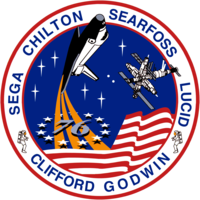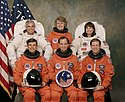STS-76
 | |
| Dane misji | |
| Indeks COSPAR | 1996-018A |
|---|---|
| Zaangażowani | |
| Oznaczenie kodowe | STS-76 |
| Pojazd | |
| Wahadłowiec | Atlantis |
| Załoga | |
 Siedzą od lewej: Ronald Sega, Kevin Chilton, Richard Searfoss. Stoją od lewej: Michael Clifford, Shannon Lucid, Linda Godwin. | |
| Dowódca | Kevin Chilton |
| Start | |
| Miejsce startu | Stany Zjednoczone, KSC, LC39-B |
| Początek misji | 22 marca 1996, 08:13:04 UTC |
| Orbita okołoziemska | |
| Apogeum | 411[1] km |
| Perygeum | 389[1] km |
| Okres orbitalny | 92,5[1] min |
| Inklinacja orbity | 51,6[1]° |
| Lądowanie | |
| Miejsce lądowania | Edwards Air Force Base, Pas startowy 22[2] |
| Lądowanie | 31 marca 1996 13:28:57 UTC |
| Czas trwania misji | 9 dni, 5 godz, 15 min, 53 sek[2] |
| Przebyta odległość | 6 115 507 km[2] |
| Liczba okrążeń Ziemi | 145[2] |
| Program lotów wahadłowców | |
STS-76 (ang. Space Transportation System) – misja amerykańskiego wahadłowca Atlantis na rosyjską stację kosmiczną Mir. Był to szesnasty lot promu Atlantis i siedemdziesiąty szósty programu lotów wahadłowców[3].
Załoga
- Kevin Chilton (3)*, dowódca (CDR)
- Richard Searfoss (2), pilot (PLT)
- Linda Godwin (3), specjalista misji (MS3)
- Michael „Rich” Clifford (3), specjalista misji (MS2)
- Ronald Sega (2), specjalista misji (MS1)
Przywieziony członek załogi Mira
- Shannon Lucid (5), specjalista misji (MS4)
(liczba w nawiasie oznacza liczbę lotów odbytych przez każdego z astronautów)
Parametry misji
- Masa:
- Perygeum: 389 km
- Apogeum: 411 km
- Inklinacja: 51,6°
- Okres orbitalny: 92,5 min
Cel misji
Trzeci lot wahadłowca na rosyjską stację kosmiczną Mir, gdzie pozostawiono astronautkę Shannon Lucid w celu realizacji wielomiesięcznej misji[3]. Na module cumowniczym zainstalowana zestaw eksperymentów MEEP[5].
- Połączenie ze stacją Mir: 24 marca 1996, 02:34:05 UTC
- Odłączenie od stacji Mir: 29 marca 1996, 01:08:03 UTC
- Łączny czas dokowania: 4 dni, 22 godz., 33 min, 58 s
Spacer kosmiczny
- EVA (26 marca 1996, 6 godz. 3 min): L. Godwin, M. Clifford.
Zobacz też
Przypisy
- ↑ a b c d STS 76 (ang.). W: NSSDCA Master Catalog [on-line]. NASA. [dostęp 2014-06-14]. [zarchiwizowane z tego adresu (2014-07-14)].
- ↑ a b c d e f g Mark Wade: STS-76 (ang.). W: Encyclopedia Astronautica [on-line]. [dostęp 2017-07-25].
- ↑ a b c Tomáš Přibyl: Dzień, w którym nie wróciła COLUMBIA. Bielsko-Biała: Wydawnictwo >DEBIT<, 2003, s. 171. ISBN 83-7167-224-1.
- ↑ Robert Godwin: Space Shuttle. Warszawa: Prószyński Media Sp. z o.o., 2011, s. 75, seria: Historia podboju Kosmosu. ISBN 978-83-7648-973-5.
- ↑ STS-76 Mir Environmental Effects Payload (MEEP), NASA, marzec 1996 [dostęp 2019-04-08].
Linki zewnętrzne
- podsumowanie misji STS-76 na stronie KSC (ang.)
- Mark Wade: STS-76 (ang.). W: Encyclopedia Astronautica [on-line]. [dostęp 2017-07-25].
- Spaceflight mission report: STS-76 (ang.). Spacefacts. [dostęp 2017-07-25].
Media użyte na tej stronie
The flag of Navassa Island is simply the United States flag. It does not have a "local" flag or "unofficial" flag; it is an uninhabited island. The version with a profile view was based on Flags of the World and as a fictional design has no status warranting a place on any Wiki. It was made up by a random person with no connection to the island, it has never flown on the island, and it has never received any sort of recognition or validation by any authority. The person quoted on that page has no authority to bestow a flag, "unofficial" or otherwise, on the island.
These six NASA astronauts launched into space aboard the Space Shuttle Atlantis on March 22, 1996 for the STS-76 mission. Pictured on the front row, left to right, are astronauts Ronald M. Sega, mission specialist; Kevin P. Chilton, mission commander; and Richard A. Searfoss, pilot. On the back row, left to right, are mission specialists Michael R. (Rich) Clifford, Shannon W. Lucid, and Linda M. Godwin. The third U.S. Shuttle-Mir docking, STS-76 began a new period of international cooperation in space exploration with the first Shuttle transport of a United States astronaut (Lucid) to Russia's Mir Space Station for extended joint space research. Clifford and Godwin, pictured here in training versions of the Extravehicular Mobility Unit (EMU), performed the first Extravehicular Activity (EVA) during Mir-Shuttle docked operations.
STS-76 Mission Insignia
The official NASA patch for the Shuttle-Mir Program, showing a Space Shuttle Orbiter docked to the Russian Space Station Mir, flying above a stylised Earth. The patch is bordered by the colours of the flags of Russia and the USA




